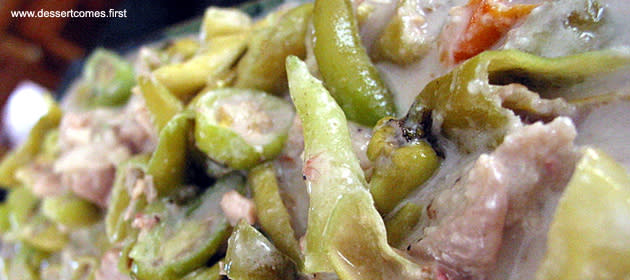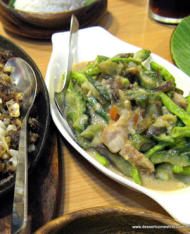Bicolano cuisine, noted by Filipinos as perhaps the most "incendiary" in the entire country, centers on what I call its holy trinity: sili (finger chili), pili nut, and gata (coconut milk, first and second extraction). The region is known for its spicy dishes, most of which are cooked using gata. With the exception of the pili, both the sili and the gata play central roles in a popular dish that bears the name of the region but ironically, isn't even Bicolano in origin.
I'm talking of course of the Bicol express, a fiery dish — and I do mean fiery — an explosive combination of green finger chilies and pork strips simmered in gata until thick. Cely Kalaw is the generally accepted inventor of this dish, along with her brother, Demitrio (Kuya Itring). They created it in the 1960s when brother and sister owned The Grove, Luto ng Inay restaurant on M.H. del Pilar in Malate. At the time, the ladies-who-lunch loved the restaurant's laing but complained that it was too, ahem, "zippy" for their tastes. So Tita Cely and her Kuya Itring cut down on the peppers and created "Bicol Express," to complement the laing for those who could handle more heat. The chili pepper used here is what I know as siling pangsigang — the long green chili used to spice up our native sinigang — although some people know it as siling mahaba (long green chilies). Our local green chilies are really not that hot — I liken them to jalapeños, which they certainly have a relation to. In this country, it's the tiny red ones that can cause profuse perspiration and trigger heart palpitations.
To get back to the Bicol Express, it was really meant to augment the laing. So goes that if one wanted his (or her) laing to be spicier, all one had to do was spoon some Bicol Express onto the laing and eat the two together; with heaps of hot white rice, of course. Bicol Express is a fabulous accompaniment to laing or vice versa. Both utilize similar ingredients but laing's main ingredient is gabi (taro) leaves and stalks boiled with ginger, chili, and coconut milk. I especially like it when the laing has bits of gabi — they provide a wonderful counterpoint to the subtle crunch of the green chilies.
As for the name, the new dish was christened such when a train happened to chug by from the Paco Railway Station that was nearby. The train's name? "Bicol Express."
Most of the Bicol Express dishes that I've seen in Manila are heavier on the pork strips with just a few slices of the green chili. It's well known that Metro Manilans (with a few exceptions) aren't predisposed to spicy cuisine. When Cely Kalaw (Tita Cely) was still alive and running her Sinigang Bar at Market! Market!, her Bicol Express was delicious enough to make a fire-breathing dragon out of anyone. It was loaded with green chilies sliced on the diagonal, cooked with just a few pork strips and simmered in coconut milk until thick. It was akin to a pyrotechnic invasion let loose in the mouth.
Reposted From Lori Baltazar of Timpla



do you have a recipe for bicol express?
ReplyDelete